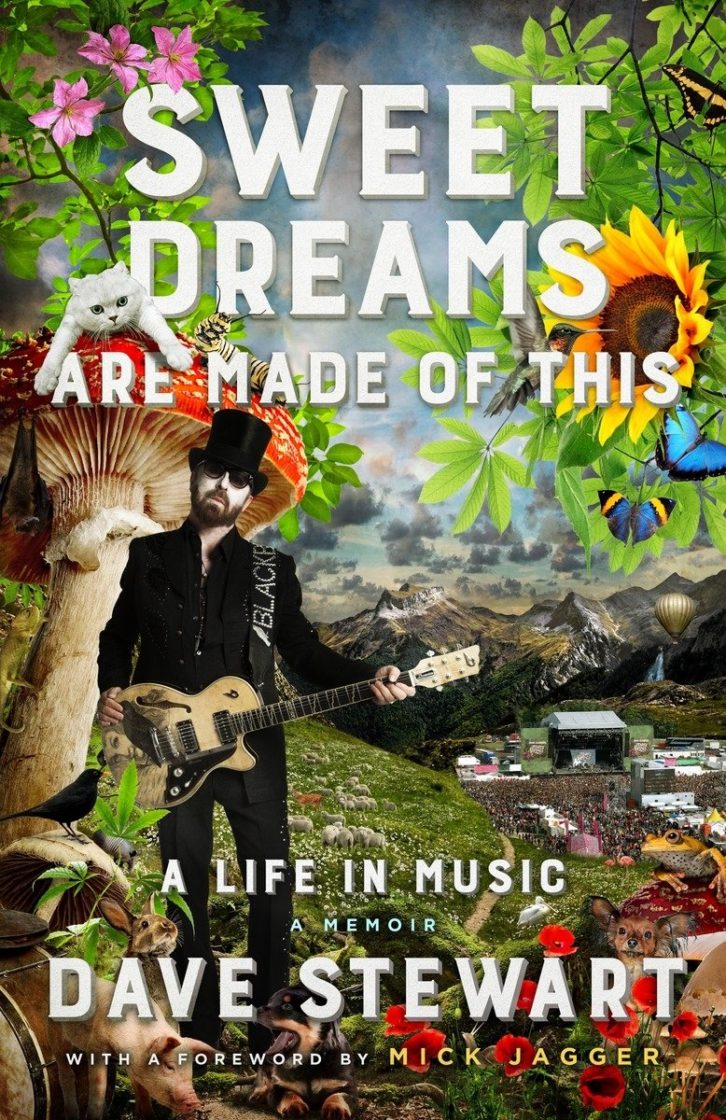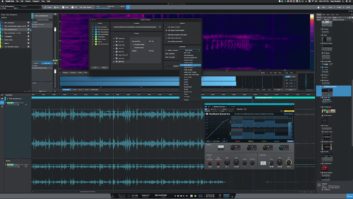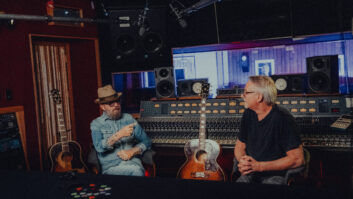

Pop star, songwriter, video director, producer, engineer, musical shaman, and the list goes on and on. Dave Stewart may be best-known as half of Eighties hitmakers Eurythmics, but in truth, the guy has worn so many hats over the years, you might as well find a jobs directory and just slap his name on the cover. Now you can add “author” to the list with his autobiography, Sweet Dreams Are Made Of This: A Life In Music (New American Library; 2016).
While he produced and often engineered Eurythmics’ chart-toppers (“Here Comes The Rain Again,” “Would I Lie To You?” “Missionary Man,” “Love Is A Stranger” and the book’s namesake being just a few of them), Stewart has also produced the likes of Tom Petty (“Don’t Come Around Here No More”), No Doubt (“Underneath It All”), Mick Jagger, Aretha Franklin, Candy Dulfer, Stevie Nicks and plenty of others, so it’s safe to say the guy knows his way around a session, not to mention superstars and the egos and insecurities that go along with them.
With that in mind, we rummaged through his book (a speedy, fun read with more hair-raising drug stories than you can shake a thai stick at) to find some insights on recording and creativity in general. There were plenty to choose from, so here’s just a handful:
1. EMBRACE LIMITATIONS
Eurythmics recorded its first album, In The Garden, in the then-cutting edge 24-track studio of German production whiz Conny Plank (Kraftwerk, Ultravox, Devo). They had the money, the personnel and the ideal setting to create their new wave sound—and the album tanked upon release.
Broke and faced with recording the follow-up, the duo begged their way into a bank loan and bought a simple TEAC 8-track recorder, a second-hand Revox 2-track to mix down to, a Klark-Teknik spring reverb, Bel noise-reduction system, Roland Space Echo and a used Soundcraft 16-input mixing desk. The only place they could afford to put all that was a cramped loft above a picture framing shop, where they couldn’t record with an open mic when the shop was in woodworking mode downstairs. This was where they recorded the breakthrough Sweet Dreams Are Made Of This album, becoming an worldwide sensation overnight.
The duo were confined to eight tracks, a prototype drum machine, a Roland SH-101 synth and, to be fair, Annie Lennox’s world-class voice—and that was all they needed. Those songs would’ve been big hits whether they were recorded in a tiny loft or the high-tech 24-track studio of a famous producer; Stewart simply made the most of what he had at his disposal and got on with it. In fact, it’s fair to wonder if having more options would have led to a less focused track.
2. BUILD THE SONG AROUND THE VOICE
Stewart writes,
“With Eurythmics, and with all my productions, I’m one of those old-fashioned record producers who likes to make music around the voice…. People want to hear and feel the emotion in the human voice, and for me that’s the most important thing to get right. There came a point in music when you could have forty-eight tracks, then seventy-two tracks or so, and just create a giant wall of music. And not a good wall of sound, like Phil Spector’s—which was crafted always around the singer—but just a big wall with no dynamics that would overcome the voice. I believed in following the voice on its journey, and that’s still my thing. The success of Adele is no surprise, as everything is built around her voice.”
3. LUCK IS THE RESULT OF HARD WORK
Some know that Eurythmics was actually created from the ashes of Stewart and Lennox’s previous band, The Tourists, which put out three albums without much success, but in fact Stewart was in another act before that: Longdancer, which released a lone, forgotten album on Elton John’s Rocket Records in the early 1970s. Despite every setback and hurdle—and sometimes Stewart was his own worst enemy, particularly at the height of his 1970s predilection for psychedelic drugs—the guy never stopped plugging away at his career, even when living in a squat, selling records in a flea market to get by.
While the book is full of wild stories of excess, there’s also brief mentions of putting in 20-hour days in the studio, of throwing away song idea after song idea while writing, of working as a road manager for other bands, of acting as Eurythmics’ manager until they hit it big, and more. A strong work ethic doesn’t make for great stories, so it tends to get brushed aside in books like this, but it’s clear if you read between the lines that Stewart had a lot of irons in the fire, pushed forward incessantly and sooner or later, something was going to pan out in his favor. When he began creating hits for Eurythmics and then for others, things clicked because he’d put in the hours, learned the craft and paid his dues. Luck happens to everyone, but the ability to capitalize on it comes down to hard work.
4. BEING SOCIABLE HELPS
Nobody wants to be stuck in the studio for 20 hours with someone who’s a drag. People who are a bummer, with ‘we can’t do that because…’ attitudes, don’t pull the same level of creativity out of others. Stewart’s book is littered with endless instances where he hung out with household names, often recording and working with them. Clearly the guy knows how to network if he wound up in those circles—and then stayed in them years after Eurythmics had run its course.
Even in life circumstances where it would be easier—and far more human—to not be friendly with others, Stewart was upbeat and in one case, it paid off in spades. Visiting his ex-wife, Peg, he met her new beau who happened to write string arrangements. While it’s clear that they were stretching to find friendly common ground, Stewart casually invited the new boyfriend to work together on a song he was recording in a decommissioned church. The result was the sweeping strings that are the signature of Eurythmics’ ballad, “Here Comes The Rain Again.”
5. IT’S SUPPOSED TO BE FUN
Time and time again, Stewart talks about being creative, and being open to experimenting and failing and experimenting again. He notes at one point:
“One of the secrets to my ability to collaborate with so many other talents is that I take all the pressure away…when I come along and say, ‘Well, you know, it doesn’t really matter if you don’t like it. Nobody will ever hear it. We’ll just throw it away, burn it. It doesn’t make a difference,’ suddenly it’s a whole new world. There is no pressure, and you’re allowed to make mistakes, and you know everything is fine. You don’t have to think everything is precious. When you’re relaxed, great things happen, and you can capture something truly amazing. And this creates momentum, because you use that energy and it leads to more ideas and inspiration. People get excited and it becomes fun. And when you’re having fun making music, it’s infectious, for yourself and everyone around you. And it’s also much nicer for your family when you, eventually, get home.”







